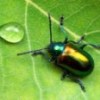
Proceratium silaceum, alate queen.
Last week at the Vermillion River Observatory I collected this alate queen of Proceratium silaceum, an odd and highly specialized subterranean predator of spider eggs. Once I finished photographing the ant I pickled it in 100% ethanol. The specimen should be in good shape for DNA work.
As Proceratium is both relatively uncommon and phylogenetically interesting, I thought I'd offer the specimen to any lab that might have use for it. Contact me if you're interested.
More like this
Proceratium californicum
By request, I have now organized the ant photos by subfamily. This mimics the arrangement from the old site. For the smug-muggers out there who want to know how it work

But, but, why waste a perfectly good, complete and rare queen for DNA when any worker would do? :(
Now, studies in comparative queen morphology will benefit greatly from the specimen! [waving arms high in the air]
Well, that's a fair point. But, DNA extraction is not so destructive as it used to be. Proteinase K digestion leaves the external morphology intact.